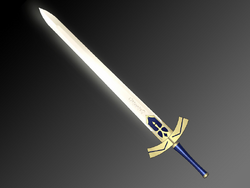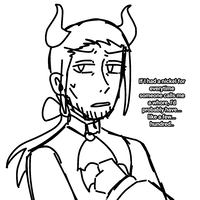Niccolo Paganini
sibchatactics
- Created
- 10 months, 26 days ago
- Creator
- sibchatactics
- Favorites
- 2
Profile
Niccolo Paganini

Niccolo Paganini (尼ッコロ・パガニーニ, Nikkorō Paganīni), Class Name Caster Of Black ("黒"のキャスター, "Kuro" no Kyasutā)is a Caster-class Servant summoned by Kanaha Kojiro in the Great Holy Grail War of Fate/Apocrypha.
He was also summoned by Ritsuka Fujimaru in the Grand Order conflicts of Fate/Grand Order.Niccolò Paganini was an Italian violinist and composer. He was the most celebrated violin virtuoso of his time and left his mark as one of the pillars of modern violin technique.
The French invaded northern Italy in March 1796, and the political situation in Genoa became unstable. The Paganinis sought refuge in their country property in Romairone, near Bolzaneto. It was in this period that Paganini is thought to have developed his relationship with the guitar. He mastered the guitar, but preferred to play it in exclusively intimate, rather than public concerts. He later described the guitar as his "constant companion" on his concert tours. By 1800, Paganini and his father traveled to Livorno, where Paganini played in concerts and his father resumed his maritime work. In 1801, the 18-year-old Paganini was appointed the first violin of the Republic of Lucca, but a substantial portion of his income came from freelancing. His fame as a violinist was matched only by his reputation as a gambler and womanizer. In 1805, Lucca was annexed by Napoleonic France, and the region was ceded to Napoleon's sister, Elisa Bonaparte. Paganini became a violinist for the Baciocchi court while giving private lessons to Elisa's husband, Felice for ten years. During this time, his wife and Paganini were also carrying on a romantic affair.[4] In 1807, Baciocchi became the Grand Duchess of Tuscany and her court was transferred to Florence. Paganini was part of the entourage, but, towards the end of 1809, he left Baciocchi to resume his freelance career.
For the next few years, Paganini returned to touring in the areas surrounding Parma and Genoa. Though he was very popular with the local audience, he was still not very well known in the rest of Europe. His first break came from an 1813 concert at La Scala in Milan. The concert was a great success. As a result, Paganini began to attract the attention of other prominent, though more conservative, musicians across Europe. His early encounters with Charles Philippe Lafont and Louis Spohr created intense rivalry. His concert activities, however, remained limited to Italy for the next few years. In 1827, Pope Leo XII honoured Paganini with the Order of the Golden Spur. His fame spread across Europe with a concert tour that started in Vienna in August 1828, stopping in every major European city in Germany, Poland, and Bohemia until February 1831 in Strasbourg. This was followed by tours in Paris and Britain. His technical ability and his willingness to display it received much critical acclaim. In addition to his own compositions, theme and variations being the most popular, Paganini also performed modified versions of works (primarily concertos) written by his early contemporaries, such as Rodolphe Kreutzer and Giovanni Battista Viotti. Paganini's travels also brought him into contact with eminent guitar virtuosi of the day, including Ferdinando Carulli in Paris and Mauro Giuliani in Vienna, but this experience did not inspire him to play public concerts with guitar, and even performances of his own guitar trios and quartets were private to the point of being behind closed doors.
Late career and health decline
Throughout his life, Paganini was no stranger to chronic illnesses. Although no definite medical proof exists, he was reputed to have been affected by Marfan syndrome or Ehlers–Danlos syndrome. In addition, his frequent concert schedule, as well as his extravagant lifestyle, took their toll on his health. He was diagnosed with syphilis as early as 1822, and his remedy, which included mercury and opium, came with serious physical and psychological side effects. In 1834, while still in Paris, he was treated for tuberculosis. Though his recovery was reasonably quick, after the illness his career was marred by frequent cancellations due to various health problems, from the common cold to depression, which lasted from days to months. In September 1834, Paganini put an end to his concert career and returned to Genoa. Contrary to popular beliefs involving his wishing to keep his music and techniques secret, Paganini devoted his time to the publication of his compositions and violin methods. He accepted students, of whom two enjoyed moderate success: violinist Camillo Sivori and cellist Gaetano Ciandelli. Neither, however, considered Paganini helpful or inspirational. In 1835, Paganini returned to Parma, this time under the employ of Archduchess Marie Louise of Austria, Napoleon's second wife. He was in charge of reorganizing her court orchestra, but he eventually conflicted with the players and court, so his visions never saw completion. In Paris, he befriended the 11-year-old Polish virtuoso Apollinaire de Kontski, giving him some lessons and a signed testimonial. It was widely put about, falsely, that Paganini was so impressed with de Kontski's skills that he bequeathed him his violins and manuscripts.
Final years, death, and burial
In 1836, Paganini returned to Paris to set up a casino. Its immediate failure left him in financial ruin, and he auctioned off his personal effects, including his musical instruments, to recoup his losses. At Christmas of 1838, he left Paris for Marseille and, after a brief stay, travelled to Nice where his condition worsened. In May 1840, the Bishop of Nice sent Paganini a local parish priest to perform the last rites. Paganini assumed the sacrament was premature, and refused. A week later, on 27 May 1840, the 57-year-old Paganini died from internal hemorrhaging before a priest could be summoned. Because of this, and his widely rumored association with the devil, the Church denied his body a Catholic burial in Genoa. It took four years and an appeal to the Pope before the Church let his body be transported to Genoa, but it was still not buried. His body was finally buried in 1876, in a cemetery in Parma. In 1893, the Czech violinist František Ondříček persuaded Paganini's grandson, Attila, to allow a viewing of the violinist's body. After this episode, Paganini's body was finally reinterred in a new cemetery in Parma in 1896.
Paganini has long, flowing black hair that is tied up into a sleek ponytail with a red ribbon. His eyes are a piercing red, and his skin is pale and flawless. His outfit is dark, with a Victorian-styled coat over a high-collared white ruffed long-sleeved shirt, accompanied by a black waistcoat. He also wears a black and red corset around his waist and a white jabot around his neck. His pants are black with yellow stripes at the sides. He had two curved black devilish horns and a long thin black devilish tail.
Paganini emanates a captivating aura that exudes both a charismatic charm and astute strategic aptitude. He exudes confidence in his abilities and fearlessly embarks on audacious endeavors. Though his demeanor may seem tough, he harbors a gentle and tender side that he tends to keep concealed from others.
"She will always surprise me.."
At first, Paganini was loyal to Kanaha, believing that she would help him achieve his own goals. However, as he began to see the true extent of her ambition and the harm she was causing, he began to question his loyalty to her. Despite this, Paganini remains bound to Kanaha by their contract, and he is forced to do her bidding even when he disagrees with her actions. As for their potential criminal activities, Kanaha could have been using Paganini's powers to help her gain wealth and influence, or to further her own political agenda. Paganini may have initially been willing to cooperate with her, but as he became more aware of the harm they were causing, he may have tried to resist her control, leading to conflict between the two. Paganini would treat Kanaha like a daugther as he was reminded of his son. He didn't care of the amount of crimes Kanaha may do, he will take care of her nevertheless."He's fun.. I like him.. I'd love to meet him again.."
Paganini's charismatic nature might clash with Moriarty's cunning schemes. While they might initially try to outwit each other, their rivalry could develop into a game of manipulation and intrigue, each trying to gain the upper hand. Their relationship is fraught with tension, as they may compete for power and control. Moriarty sees Paganini as a useful pawn in his schemes, while Paganini may not be willing to be used as such. Whilst being 'rivals', the two would fond over each other, planning schemes to make the other surrender. They both have to admit that they respected the other, but what could possibly go wrong with friendly fire?"He's.. a prideful man..."
Paganini admired Napoleon for his strategic brilliance and leadership qualities. Napoleon's ability to command on the battlefield could intrigue Paganini, who recognizes a different kind of mastery in Napoleon's actions. This admiration formed the basis of mutual respect between them. Despite their differences in expertise, Paganini's fiery charisma and Napoleon's commanding presence lead to a subtle rivalry. They engage in friendly banter, with Paganini playfully challenging Napoleon's tactics and Napoleon teasing Paganini about the practicality of music in battles."Come to Papa Paganini! Better than Moriarty!"
Paganini's devilish nature and Jack the Ripper's brutal tendencies could create a complicated relationship, with Paganini possibly acting as a mentor or guide to Jack as she navigates her existence as a notorious serial killer. Jack the Ripper is a Assassin class servant, and her mental state is unstable due to her identity as a legendary killer. This is difficult for her to form a close relationship with anyone, including Paganini. Paganini would always try to temper Jack's violent tendencies and help her find a purpose beyond killing. Paganini's musical abilities calm Jack's inner turmoil and provide a sense of peace, though it's uncertain how effective this would be. When she's calm, she'd cling onto Paganini the whole day until she needs to rest."Musicians alike I presume.."
Paganini and Mozart, both renowned musicians, could share a mutual respect for each other's musical talents. They might engage in friendly competitions, trying to outdo each other with their compositions. Their shared passion for music could form a strong bond. Even though their personalities are very different, with Mozart's energetic tone and Paganini's playful demenor, the two made a good duo.Rapsodia dell'Inferno: Capriccio ardente

"Since when did I sold my soul?.."
Incantation:"Legends weave my tale, of a pact forged in shadows, flames stoked by a rumored infernal bond. Let them talk; let the strings sing and the inferno rage. Rapsodia dell'Inferno: Capriccio ardente!"
Paganini uses the bow of his violin and taps the tip of the bow to the ground and creates a full sigil. Paganini then stood in the middle of the sigil and played his 'Caprice No.5'. Fire surrounded him as a black figure appeared from the ground, it appears to be Paganini but with more of a devilish look. The figure roared as the fire began to spread, hitting the enemy. The devilish figure would soon run towards the enemy and 'possessing' them, causing the enemy unable to move for a few minutes, paralyzing them.
Text
[servant name] was designed by [designer name] for Fate/Grand Order on 00/00/0000
Code by ThatBat + edits by Ptipi




